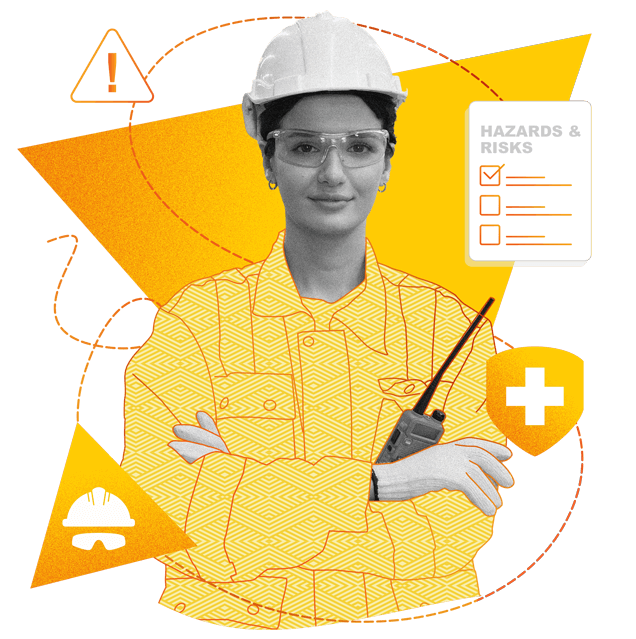Be the first in the race to create a centralised repository of possible threats and potential measures on hazards and risks
with our HIRA module.
Controlling hazards getting out of hand?
The challenge to correct the identification of threats and huge risks, both hazardous and non-hazardous is just the beginning. For an organisation, its manufacturing plant, or a scalable operation, moving in that direction; they never cease to exist.
Duplication of data
Due to the lack of better record-keeping practices, fragmented data-entry processes, limited data visibility and coordination, and more; it becomes impossible to address this issue. Instead, it requires a multifaceted approach that encompasses standardisation, interoperable information systems, data governance frameworks, staff training, and quality assurance mechanisms.
Data Collection and Updation
Without a HIRA module, organisations may face challenges in efficiently conducting hazard risk analyses and maintaining up-to-date information. Gathering relevant data for risk assessments can be time-consuming and complex, while the inability to dynamically update information hampers adaptability to changing conditions, potentially leaving the organization vulnerable to unforeseen hazards and compliance gaps.
Audit and Reporting Difficulties
Stemming from unorganised record keeping and reliance on physical documentation, these challenges impede the efficiency and accuracy of audits. Locating specific documents becomes laborious, hindering collaboration among audit teams, while manual data entry increases the risk of errors in analysis. Additionally, physical records are vulnerable to loss and damage, posing compliance concerns.
Poor records retrieval
Posing as a problem due to the absence of a structured record management system, leading to difficulties in locating documents efficiently. Without clear procedures or centralised oversight, individuals may struggle to identify where records are stored and who is responsible for them, resulting in prolonged search times. This impedes decision-making, operational efficiency, and customer service, highlighting the need for a robust record management system with standardised procedures and clear accountability.
Involvement, Collaboration, and Accessibility
When stakeholders of the organisation go-ahead with ISO 45001 implementation, they often encounter obstacles due to conflicting priorities, while reliance on physical documentation compounds these issues by obstructing accessibility, scalability, and traceability. Additionally, dispersed documents in varied formats hamper efficient access, decision-making, and scalability, rendering the backtracing of records a laborious and time-consuming endeavor.
Specific to Large Organisations
Ensuring consistency and standardisation across the entire entity poses a significant challenge. The sheer scale and complexity of operations make it difficult to maintain uniformity in processes, procedures, and record-keeping practices. This lack of consistency increases the risk of errors, discrepancies, and non-compliance with industry regulations and legal requirements. Often the failure to adhere to regulatory standards can have serious consequences, including financial penalties, legal liabilities, and reputational damage to the organisation.
Rescue your business, production, and operation from the hassle of hazard analysis and risk assessment with the paperless model of
our HIRA module.

Flag, tag and track the potential threats to your business!
As against each of these issues, the HIRA module offers a wide array of both, intelligent and click-based features to easily allow the management or users to align seamlessly with the existing risk record process.
Flag, tag and track the potential threats to your business!
As against each of these issues, the HIRA module offers a wide array of both, intelligent and click-based features to easily allow the management or users to align seamlessly with the existing risk record process.
On-the-go documentation of Risks and Hazards
Capturing every potential risk and hazard across locations to create a Risk Statement detailing the description of the risk/hazard, cause, and impact, the module eliminates or reduces the chances of issue precedence or escalation.
Matched level of Risk with Control matrix
Mapping out the available measures and corrective actions to mitigate risks, the module offers integrated risk rating, with which the stakeholders can not only collaborate and engage to find solutions; but can also determine the frequency, severity of impact, and residual risk rating, and assign the tasks accordingly.
Signed-off Risk Statements
Leveraging a dynamic approval workflow before publishing to the HIRA Register, the module ascertains that whenever there is a change or update to the Risk Statement, it archives older versions and gives you a preview of the version change history.
Proactive Access to Record-keeping
Flagging and tagging, tracking and reporting the activities as well as Risk Statements, the ready reckoner allows filtration to narrow down to the search, find appropriate documents, and easily share or download these statements.
Digitisation, Standardisation and Subjectivity
Intending to streamline risk assessment processes within organisations, implementing dynamic updates allows for ongoing revisions based on changing circumstances, reducing subjectivity by incorporating objective data and evidence-based criteria into assessments.
Had These Questions?
It is generally cumbersome to manage physical documentation, especially in a large organisation. Thereby, one requires the module for volumes in record-keeping.
Yes. One requires a thorough understanding of environmental and occupational health and safety management to effectively implement and efficiently operate the module.
Yes. The HIRA module is ideal for the new employees of the organisation as digital platforms facilitate training for them, making it easier to explain or train them on the risk framework.
With defined workflows and automation, it offers a continuous improvement on the module, an easy retrieval of the records as well as facilitates integration of the existing management systems.
Yes. Under the HIRA module, a custom risk assessment framework can be created to suit the organisational goal.

Operations Management Simplified!
Pyraman, a cloud-native SaaS that ensures QMS and EHS management for growth and excellence.
Core Modules
Additional Modules
Agile Platform
and a Ready-to-use Solution for many systems in any industry.


